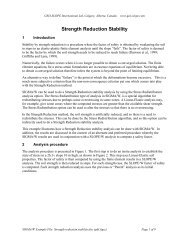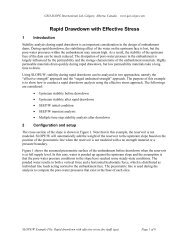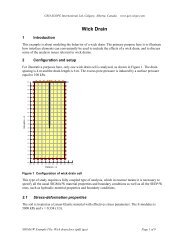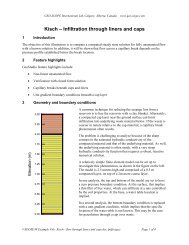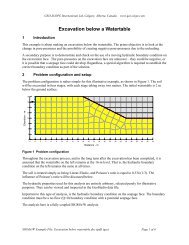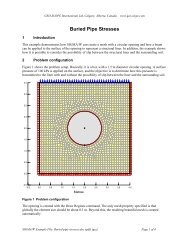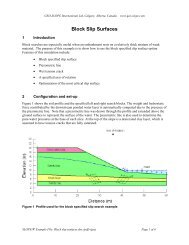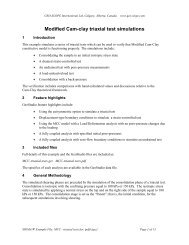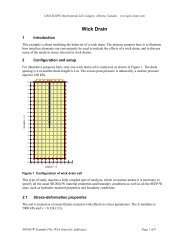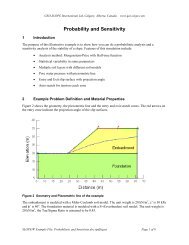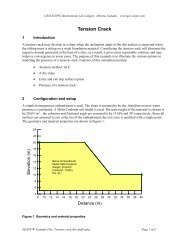Seepage Modeling with SEEP/W - GeoStudio 2007 version 7.22
Seepage Modeling with SEEP/W - GeoStudio 2007 version 7.22
Seepage Modeling with SEEP/W - GeoStudio 2007 version 7.22
You also want an ePaper? Increase the reach of your titles
YUMPU automatically turns print PDFs into web optimized ePapers that Google loves.
Chapter 2: Numerical <strong>Modeling</strong><br />
<strong>SEEP</strong>/W<br />
Fine<br />
Coarse<br />
Material to be<br />
protected<br />
OR<br />
Coarse<br />
Fine<br />
Material to be<br />
protected<br />
Figure 2-9 Two possible earth cover configurations<br />
1.00E-04<br />
Conductivity<br />
1.00E-05<br />
1.00E-06<br />
1.00E-07<br />
1.00E-08<br />
Coarse<br />
Fine<br />
1.00E-09<br />
1.00E-10<br />
1 10 100 1000<br />
Suction<br />
Figure 2-10 Hydraulic conductivity functions<br />
After conducting various analyses and trial runs <strong>with</strong> varying rates of surface infiltration, it becomes<br />
evident that the behavior of the cover system is dependent on the infiltration rate. At low infiltration rates,<br />
the effect of placing the fine material over the coarse material results in infiltration being drained laterally<br />
through the fine layer, as shown in Figure 2-11. This accomplishes the design objective of the cover. If<br />
the precipitation rate becomes fairly intensive, then the infiltration drops through the fine material and<br />
drains laterally <strong>with</strong>in the lower coarse material as shown in Figure 2-12. The design of fine soil over<br />
coarse soil may work, but only in arid environments. The occasional cloud burst may result in significant<br />
water infiltrating into the underlying coarse material, which may result in increased seepage into the<br />
waste. This may be a tolerable situation for short periods of time. If most of the time precipitation is<br />
modest, the infiltration will be drained laterally through the upper fine layer into a collection system.<br />
So, for an arid site the best solution is to place the fine soil on top of the coarse soil. This is contrary to<br />
what one might expect at first. The first reaction may be that something is wrong <strong>with</strong> the software, but it<br />
may be that our understanding of the process and our general thinking is flawed.<br />
A closer examination of the conductivity functions provides a logical explanation. The software is correct<br />
and provides the correct response given the input parameters. Consider the functions in Figure 2-13.<br />
When the infiltration rate is large, the negative water pressures or suctions will be small. As a result, the<br />
Page 12



